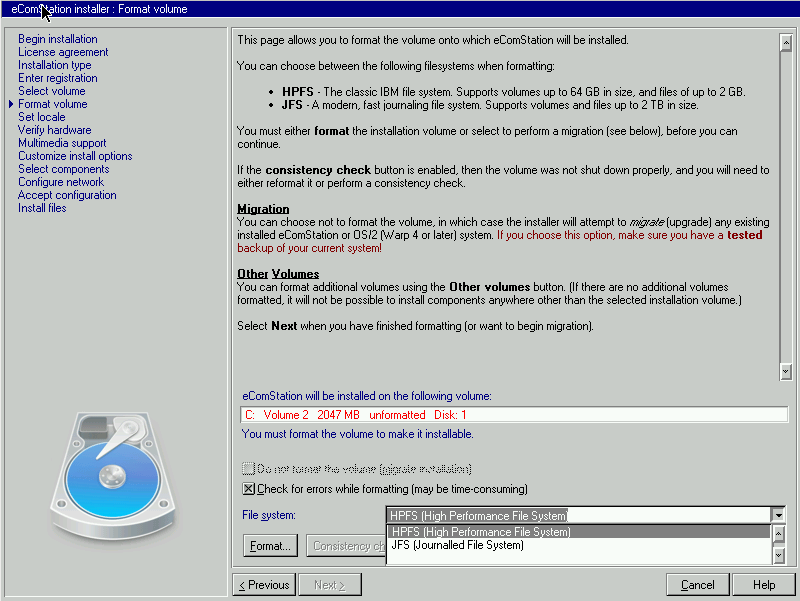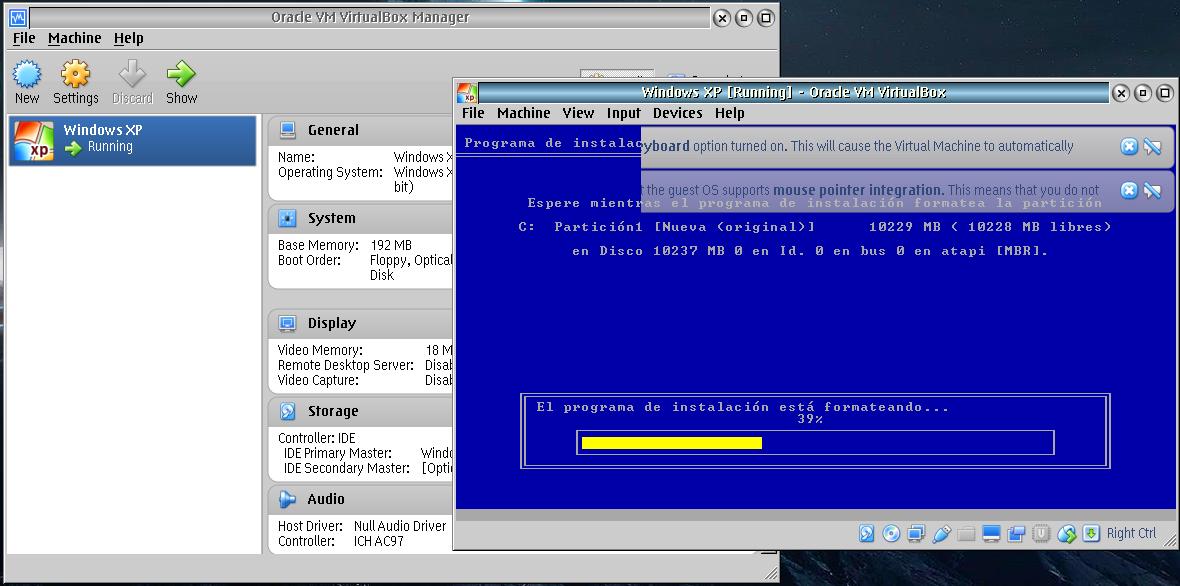- Windows 7 Iso Virtualbox Download
- Ecomstation 2 Iso Download Virtualbox 7
- Ecomstation 2.1
- Ecomstation Torrent
In eComStation 2.2 ACPI has been switched on by default when eComStation is not installed in a virtualmachine such as Virtualbox or Virtual PC. This will enable eComStation to boot on modern hardware with a much higher degree of success. This will also resolve the TRAPS/hangs on loading screen01.sys. TITLE: eComStation 2 - installation (inside VirtualBox) DATE: 2010-11-08 13:06:59. EComStation comes in two CDs (you can download them as iso images to save some money) and third iso was with OpenOffice.org (however, the newer version was released recently). It took me about 7.5 minutes on real hardware and about 10 minutes on.
- I have never used any OS/2 version earlier and I tried eComStation 1.xx only several times so I could not compare them. However, I'll point out some things I read in the internet. EComStation comes in two CDs (you can download them as iso images to save some money) and third iso was with OpenOffice.org (however, the newer version was released.
- How to install a iso file on Virtualbox virtualbox boot from iso image how to install iso file in virtualbox how to install os in virtualbox using iso virtualbox create vm from iso.
It was a cold and dreary day on September 25, 1996, and IBM had just announced their new OS/2 Warp 4 operating system. Although seen as technically superior when put up against the wildly-popular Windows 95 from Microsoft, IBM announced that this version would be the last it would ever release. It was a sad day for OS/2 fans everywhere, yet there was talk about keeping the platform alive, post-IBM.
Enter Serenity Systems and Mensys BV, two companies that decided to take the torch from IBM, in a quest to produce a solid thick-client successor to OS/2 called eComStation. This effort was kick-started around the year 2000, and has been actively supported to this day. With eComStation customers ranging from Boeing and Colgate Palmolive, to banks and even the US Postal Service, the OS/2 platform is still quite alive and well.
In a few months, Mensys BV, the developer for eComStation, will be launching the next major release for their operating system, version 2.2. I will be covering the pre-release beta that Mensys BV's own Roderick Klein issued to me for review, but to understand why OS/2 is still even around and serviceable well into the 21st Century, we need to take a step back in time to gain a better understanding of the platform.
Microsoft Weekly Newsletter

Be your company's Microsoft insider with the help of these Windows and Office tutorials and our experts' analyses of Microsoft's enterprise products. Delivered Mondays and Wednesdays
Windows 7 Iso Virtualbox Download
Sign up today Sign up todayProduct Information:
- Title: eComStation 2.2
- Author: Mensys BV
- Product URL: http://ecomstation.com
- Price: $149 for Home and Student edition / $259 for Business edition
- Bottom Line: If you are running legacy OS/2, Win16 and DOS applications, you can't go wrong with eComStation. With the multitude of improvements made to the OS, this product is most definitely worth a good look, especially once version 2.2 is released.
An abridged history
OS/2's origins as an operating system can be traced as far back as 1985, when Microsoft and IBM teamed up to begin development on was supposed to be the next step forward in operating system technology and design. Built to spec with a 16-bit protected mode kernel, support for the Microsoft-built High Performance File System (HPFS), and TCP/IP networking, OS/2 had a lot going for it. OS/2 1.3 was the definitive release between the two companies, which set a look and feel that would be later adopted by Microsoft's Windows 3.x user interface.
(Credit source image to os2voice.org)
Of course, this love affair between Microsoft and IBM was to only last for a few years before Microsoft started to realize that Windows was taking the world by storm and not the much-touted OS/2 platform. To that end, the Microsoft and IBM alliance disbanded, leaving IBM as the sole entity to develop and sell OS/2 for the greater part of the 90s.
Because of IBM's vast reach in the enterprise, OS/2 did manage to secure enough of a following that a newer thick-client was a justifiable proposition. Thus, eComStation was born and continues on IBM's legacy. Not to mention, with older hardware dying out, eComStation is essential for providing OS/2 and Win16 application support while providing updated drivers to support newer hardware.
An inside look
With Mensys as the developer of their OS/2 product eComStation, new features have been slowly added in on top of IBM's latest version, such as support for a flashy VESA graphics driver called Panorama (which now supports widescreen modes out of the box), newer hardware support, and a vastly improved installer. In the upcoming eComStation 2.2 version, Roderick Klein of Mensys states how this release will bring sweeping changes to better improve usability as well as hardware compatibility.
The first and most striking thing to hit the screen with version 2.2 is the newly updated icon set for the user desktop. Unlike the old-fashioned, pixelated icons of yesteryear, Mensys has upped the ante with a refreshed high-resolution PNG icon pack, bringing the operating system into the modern era in the looks department, which isn't a bad thing honestly. With this change however, all of the same user interface interactions are preserved, such as the 'right-click and drag' trick to create aliases of files on the desktop, the always present 'menu bar' and of course resource forks.
Ecomstation 2 Iso Download Virtualbox 7
As mentioned earlier, Win16 applications (and to some extent Win32 applications via the ODIN compatibility layer) are supported in eComStation. It's important to point out that support for older 16-bit Windows code can actually be a boon for businesses stuck with legacy software they don't wish to rewrite. Win-OS/2, a rebranded Windows 3.1 operating environment, is the software that lends such support to OS/2 and is bundled with each copy of eComStation. A huge benefit to this arrangement is that you can run all your apps within several Win16 instances, such that if one app crashes, it won't bring down the other apps, since they are appropriately sandboxed. A shared clipboard, allowing for copy and paste between DOS textmode and GUI applications is the icing on the cake.
Compared to previous releases of eComStation, I have had much more of my hardware supported out of the box, thanks to the major improvements made to ACPI, multi-core processor, USB, sound, and network card support. For instance, the network drivers seen for newer Realtek hardware is all based on Linux source-code ported to OS/2 via GENMAC. According to Mensys, it can take an experienced developer less than two days to port any given network driver over to eComStation, using the GENMAC wrapper. Audio cards also take advantage of the OS/2 port of Linux's ALSA, giving you sound capability when a native OS/2 driver doesn't exist.
With the improved networking stack, the support for the modern Web couldn't be any better for this breed of operating system. Instead of using the ancient Netscape Navigator, you now have the option of using a native OS/2 port of Firefox, which from what I can tell keeps in lockstep with Mozilla's ESR or extended service release schedule. What this means is that you can expect a relatively modern web experience while taking advantage of browser codebase consistency. Despite only having version 10 of Firefox at this time, it is anticipated that Mozilla 17.x.x ESR will be ready to go right around eComStation's 2.2 release. Even Adobe's latest version of Flash 11 is available and bundled on the install disc, so you can have a fuller Web-surfing experience.
eComStation also does away with HPFS as the default file system in favor of the IBM-developed JFS, which is arguably a far superior file system for hard disks, by offering journaling and support for partition sizes up to two terabytes (versus a 64 gigabyte max for HPFS). As recently as version 2.1, JFS boot was also incorporated, removing the need for an HPFS boot partition. Just a fair warning though, the Win16 mode on eComStation doesn't take too kindly to the newer JFS and partitions sizes past two gigabytes. For my test install, I opted for a 2GB HPFS C: drive while partitioning the remaining 198GB as a secondary data partition, formatted in JFS so as to mitigate this concern.
Want to find software to download and install? Typically, most OS/2 veterans descend upon the Hobbes OS/2 archive, which is run by New Mexico State University, even to this day. On the other hand, newcomers to eComStation might want to give the eCoMarket a spin. This feature acts as an app store or central download repository for popular OS/2 applications, making it easy to find whatever you are looking for in any particular category. As of this writing, there aren't too many applications listed yet, but that number will continue to grow and look healthier by launch.

Finally, despite being tagged as a beta release, I have suffered nary a lockup or a crash on my test installation. The operating system is quite stable and, because of the esoteric codebase, there aren't any viruses and malware out in the wild that could affect your system. Even Mac OS X can't really say that anymore, given to the rise in popularity of Apple hardware.
Conclusion
To wrap this all up nicely, eComStation is an excellent business solution for those stuck in legacy land, all the while providing a relatively modern environment that compares well against the likes of Windows and Linux. eComStation is offered in two flavors, Home and Student as well as Business editions. The only real difference between the two is the pricing, with Home and Student clocking in at $149 per license for up to five machines and Business raking in $259 per license. Both editions are functionally the same and feature-complete.
Ecomstation 2.1

Ecomstation Torrent
Pricing like this can be somewhat off-putting to operating system hobbyists and enthusiasts, but for businesses that rely on OS/2 and Win16 apps for day to day use, the price is pretty spot on, and you can get up to one year of support included for additional software and updates. Thankfully, the base installation contains everything you really need to get started and all of IBM's fixpacks from years gone by that you would normally have to pay for are all rolled in as well.
If you prefer, eComStation can be installed in a VirtualBox VM, using VT-x technology to deliver bare-metal access to the CPU. This mode is required for OS/2 and eComStation, due to the complex nature of the system kernel and resource handling. If you don't have a VT-x capable processor, your only means of using eComStation is through installation on real hardware.
In the coming months, Mensys is expected to have a brand spanking new live demo CD, based on the latest 2.2 release, which will allow you to give eComStation a spin for free. You won't be able to install the OS to your hard disk, but it will give you enough of an idea as to whether or not eComStation is right for you.